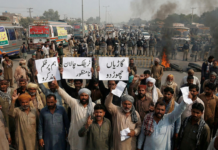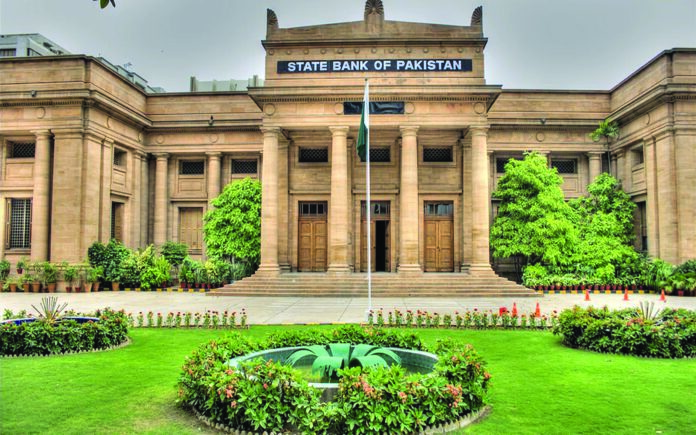The policy rate has been hiked by 125 basis points (bps), bringing it to 15% – the highest since 2008. The decision to hike is in line with market expectations. However, the Monetary Policy Statement (MPS) released by the State Bank of Pakistan (SBP) shows there’s more than meets the eye.
Between the lines: SBP stepping out of character
The MPS placed a considerable amount of emphasis on inflation. Even during the press conference, acting Governor Murtaza Syed talked about how the SBP feels the pain of a common citizen battling inflation in these testing times.
The MPC states that headline inflation is likely to remain elevated around current levels for much of FY2022-23. It believes that inflation will fall “sharply” to the 5-7% target range by the end of FY2023-24. References to runaway inflation (very rapid growth in inflation rates) were also made.
The MPC notes that without decisive macroeconomic adjustments, there is a significant risk of substantially worse outcomes that would compromise price stability, financial stability, and growth.
“This could take the form of runaway inflation, foreign exchange reserve depletion, and the need for sudden and aggressive tightening actions later that would be significantly more disruptive for economic activity and employment,” warned the statement.
Unlike itself, the SBP stepped out of character and started giving policy advice that would help the current account deficit narrow. The suggestions were around ways to bring down energy imports.
“…for instance, through early closure of markets, reduced electricity use by residential and commercial customers, and greater encouragement of work from home and car pooling”. The MPC noted that, without such measures, containing the trade deficit could become challenging.
At this moment it seemed like the SBP was addressing the government telling them to get their act together because there is a limit to monetary tightening that the SBP can do in a cost-push inflationary environment. It was a signal of “do more” to the government.
In a question posed by Profit about inflation, Syed did admit that while inflation was primarily cost-push, the decision to hike policy rates despite that was to contain demand-pull inflation. He added that there was no pressure from the IMF to hike policy rates.
Speaking of the IMF, the SBP called the reversal of the “unsustainable” energy subsidy package an encouraging development. The statement also noted that the FY2022-23 budget was centered on strong fiscal consolidation. “This has paved the way for the completion of the on-going review by the IMF programme, which will ensure that rail risks associated with meeting Pakistan’s external financing needs are averted.”
The SBP also stressed the importance of the completion of the ongoing IMF review. It said if completed, it will “catalyze important additional funding from external sources that will ensure that Pakistan’s external financing needs during FY23 are met. Pressures on the rupee should then attenuate and SBP’s foreign exchange reserves should gradually resume their previous upward trajectory during the course of FY23.”
However, again, unlike itself and beyond its concerns, the SBP talked about the nature of taxes and the impact on citizens.
It stressed the importance of the need for new taxes to be progressive in nature.
“In particular, their burden should mainly be absorbed by the relatively better off while adequate protection is provided to the more vulnerable, for whom high food prices are a particular concern. In this context, curbing food inflation through supply-side measures aimed at boosting output and resolving supply-chain bottlenecks should be a high priority”.
Lastly, one detail that seems to be ignored is the SBP making an announcement regarding future MPC decisions. The MPC announced that, going forward, it will remain data-dependent, paying particularly close attention to month-on-month inflation, the evolution of inflation expectations and global commodity prices, as well as developments on the fiscal and external fronts. This has been a demand of the IMF since March 2021.
Does this mean decision-making up to this point was sentiment-driven, narrative, or story-driven? Not a comforting thought
Recap: Build-up to the hike
Conducting MPC meetings and announcing the policy rate is a routine matter at the SBP. However, this policy rate decision was highly watched as it set the stage for what is to come.
Usually, in an inflationary environment, the SBP hikes the policy rate to reduce the money supply. This in turn brings down demand which brings down inflation.
However, the macroeconomic environment has kept the central bank on its feet lately. For the sake of simplicity, we’re going to recap everything that went down in June, building up to the MPC meeting.
Before we begin with June, just a reminder that on May 23, the SBP hiked the policy rate by 150 bps. It talked about fiscal austerity in the policy statement, a recent development.
June 9:
Despite the policy rate hike, things seemed to further deteriorate on the macroeconomic front. On June 9, the SBP held a confidential meeting with bank treasurers instructing them to bring down yields in the t-bill and PIB auctions. They were threatened with a supertax in case they didn’t comply. The banks were also asked to incur foreign exchange losses if needed, but to take pressure off the rupee as it was a national issue.
June 16:
Things then took a turn for the worse. Profit reported that the interbank had run out of dollars. This was based on the fact that forward premiums had turned into discounts in the interbank, signifying banks were desperate to get dollars. The last time this happened was in November 2021. The SBP conducted an emergency MPC to hike up policy rates back then.
June 20:
This foreign exchange liquidity crunch got more serious, and banks began turning away letters of credit (LCs). Importers in the country faced administrative delays in the processing of their LCs or plain outright refusal. There simply was not enough foreign exchange.
June 21:
To deal with the crunch, the SBP allowed banks to cut their Cash Reserve Requirement (CRR) and Statutory Cash Reserve Requirement (SCRR) in an attempt to boost interbank liquidity. The SBP did not formally come out and declare a percentage of a cut and instead decided on a case-to-case basis with each commercial bank based on the request put in by the bank. Based on Profit’s analysis, a 1% drop in the CRR or SCRR injects $72.88 million into the interbank based on the total foreign exchange deposits of $7288 million as of May 2022.
June 22:
Amidst all this doom and gloom, the SBP posted a congratulatory tweet about $57 million inflows into Roshan Digital Account (RDA) deposits, the highest ever daily inflow. Profit fact-checked this to find that the SBP was not announcing net deposits, but simply cumulating the inflows each month – and that the reserves are not equivalent to $4.5 billion. We understand that this was a move to instill confidence in the market that there are indeed dollar inflows.
June 26:
While foreign exchange still remained a concern for the central bank, they had rising yields in auctions to worry about as well. The SBP conducted a 77-day OMO injection. This is the longest OMO tenor ever introduced by the SBP. A sum of PKR 402 billion was injected through this OMO expected to mature in mid-September. The SBP has already locked in 94% of outstanding OMOs worth PKR 4.1 trillion in 63-day tenors. This means that a vast majority of funds through OMOs are in the form of longer tenors. Hold on to this information, we will jump back to it when we talk about the auction held on June 30.
June 29:
There is, however, a limit to how much banks can borrow through OMOs. The SBP then had no choice but to relax the leverage ratio for banks. On June 29, the SBP made an update to Basel III FAQs, relaxing the method of calculating the leverage ratio. Since the SBP can’t lend directly to the government, it uses OMOs to lend indirectly. With banks borrowing near their limit, the SBP used this method to help the government raise money in auctions.
The SBP also sat down with banks and talked about the possibility of reclassifying loss-making bonds in the Available For Sale (AFS) portfolio of banks as Held to Maturity (HTM) at cost. If the SBP allows this reclassification, it would be easier for commercial banks to meet capital adequacy. At this point, it seemed like the banks were stringing along the SBP. The power dynamics have certainly changed – something we will get back to.
June 30:
Remember the OMO injection on June 26? It was primarily done to provide the market with cheap liquidity hoping to bring the yields down in the Market Treasury Bill (MTB) auctions. The too long; didn’t read (TL;DR) is that it did not work, and yields did not come crashing down. However, the government, out to raise a target of PKR 800 billion, instead managed to raise PKR 1.74 trillion. The excess liquidity through OMO and leverage ratio relaxation was picked up by the government. The market placed bids of PKR 2.37 trillion, which shows you how much money the banks are now sitting on.
What is important to note here is that participation remained concentrated in the three-month tenor with bids of PKR 1.9 trillion. The government accepted bids of PKR 1.7 trillion. Due to the heavy participation, the cut-off yield managed to decrease by 2 bps to 15.23% compared to the previous auction. Some 176 bids in total were made in the 3-month MTB, the lowest 14.5449%, and the highest 16.49%. This means the market is expecting a rate hike.
In a weird turn of events, the SBP then also conducted a reverse OMO to MOP-UP excess liquidity from the market. As we’ve pointed out, the banks had a lot of money to invest in MTBs, the government picked up as much as it could. With banks reluctant to lend to the private sector during the current macroeconomic climate, the SBP conducted a four-day OMO mop-up and picked up PKR 392.6 billion at a rate of return of 13.65% per annum.
July 4:
Conducting a mop-up is saying the market has too much liquidity and it’s time to pick some up. However, on July 4, the SBP decided to conduct a 74-day OMO. At this point, the market no longer gets surprised at longer tenor OMOs because this just seems like the SBP’s new style. What was strange about this OMO is that the SBP conducted the injection asking for bids and then rejected all of them. Okay, fair enough – they probably changed their mind or just didn’t like the range of the bids. Twenty-eight bids that were placed by participants, ranging from 13.97% to 13.84% to raise PKR 1.91 trillion, were rejected by the SBP.
July 5:
After rejecting all bids in an OMO a day before, the SBP conducted a 73-day OMO injection. Twenty bids were placed ranging from 14.07% to 13.87%. The SBP offered PKR 1.371 trillion but only accepted nine bids worth PKR 1.186 trillion at a 13.97% annual rate of return. Maybe this was the SBPs way of getting a better rate of return for itself and signaling to the market that it’s no longer bowing down to the markets?
The foreign exchange liquidity crunch turned into a serious issue; however, through the SBP’s steps of cutting the CRR, and SCRR, the market got its much-needed foreign exchange liquidity. As a result, the declining rupee stabilised, as opposed to the value it was shedding amidst the chaos. Unlike last time, the SBP did not need to go down the emergency MPC route.
While the SBP was able to deal with the foreign exchange issues, the yields have remained a point of contention between the central bank, the finance ministry, and commercial banks. In December 2021, the then finance minister Shaukat Tarin threatened banks with “koonda” on live television.
This time around, banks were threatened rather discreetly, and rewarded with OMO injections and relaxation in the leverage ratio. More importantly, the fact that the SBP is in talks with banks to reclassify loss-making bonds is enough to show which side has bargaining power. With the regulator saving banks from incurring operational losses, something which is a fair element of businesses, one has to wonder about the larger picture.
Despite that, the market did not bid lower. After all, why would they? They’re banks, not charities. Like we’ve said in the past, expecting banks to not be greedy is like expecting a great white shark to go vegan.
Will banks yield to the SBP?
The hike in policy rates was also driven by the fact that the SBP was behind the curve. The markets have been pushing for higher yields, as a result, the spread between the policy rate and yields has significantly widened.
During the press conference, in response to a question posed by Profit, the SBP explained that the decision to hike policy rates and use OMOs was to bring down the substantial spread between the yields, Kibor, and the policy rate.
Profit also asked the SBP whether hiking policy rates despite locking in long-term OMOs would confuse the market. The response given was that the MPC is an independent body with independent members and representation from the SBP. The deputy governor added, “Going forward if the policy rate and market rate have a substantial difference, the SBP will take necessary action to realign rates.”
Speaking to bank treasurers, Profit has been informed that banks are placing higher bids in line with inflation expectations. “Why would we incur a real loss, considering inflation is higher than the rate of return we’d get. We’re answerable to shareholders,” said a source.
“However, it is true that banks may put in lower bids if they knew they’d be rejected. The government is desperate for money. The confidential meeting at the SBP with banks proved it. This was reiterated later through the auction where they took up more than their target. Every time the SBP gives us liquidity through OMOs, we know we’ve got the upper hand,” he adds.
According to the SBP Act, Section 409 C, the SBP shall not purchase securities issued by the government or any government-owned entity or any other public entity in the primary market. The central bank may purchase such securities in the secondary market. Following this, the government is now dependent on the private market to raise debt. This is not bad. When the government would simply borrow from the SBP, it would be inflationary considering the rising money supply.
While borrowing from the private market does not always mean the market has the upper hand, it is important to note that the government’s spending pattern put it in this position. With previous debt to pay off, government operations to spend on, and in the absence of true fiscal austerity, the government has inadvertently left itself at the mercy of banks. Meanwhile, the SBP finds itself caught in the middle of this mess.

























Who knows what’s going to happen.
I dеfinitely loved every little bit of it and I have you book marked too check .
온라인 카지노
j9korea.com